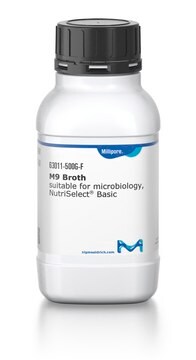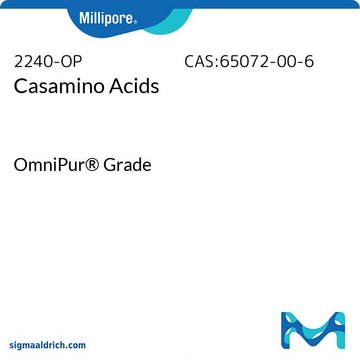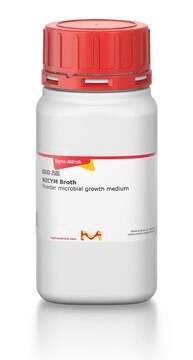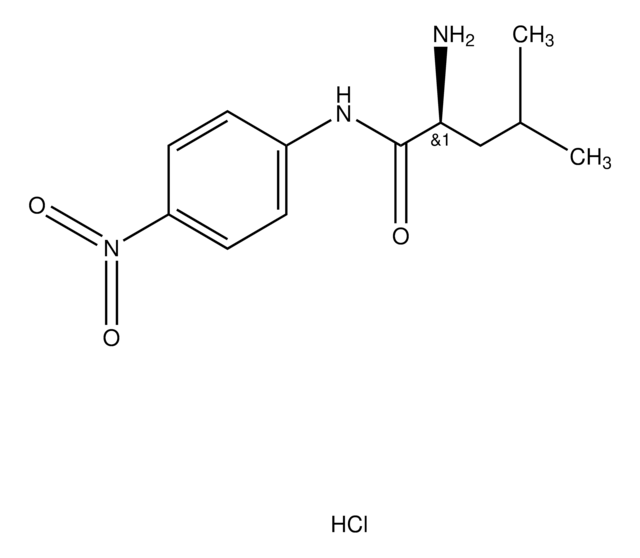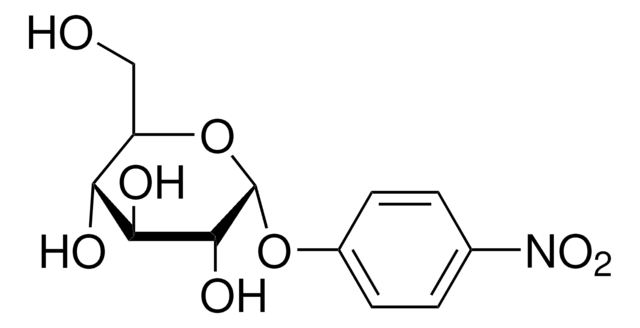M6030
M9, Minimal Salts, 5X
powder, minimal microbial growth medium
Sinônimo(s):
M9 media
Faça loginpara ver os preços organizacionais e de contrato
About This Item
Código UNSPSC:
12352302
NACRES:
NA.85
Produtos recomendados
grau
Molecular Biology
for molecular biology
Nível de qualidade
esterilidade
non-sterile
Formulário
powder
composição
KH2PO4, 15 g/L
NaCl, 2.5 g/L
Na2HPO4, 33.9 g/L
NH4Cl, 5 g/L
aplicação(ões)
food and beverages
temperatura de armazenamento
room temp
adequação
nonselective for Escherichia coli
nonselective for coliforms
Descrição geral
M9 Minimal Salts is a highly-referenced microbial growth medium used for the cultivation of E. coli. This buffered minimal microbial medium contains only salts and nitrogen, so it is traditionally supplemented with glucose, amino acids and vitamins as needed.
Aplicação
M9, Minimal Salts, 5X has been used:
- in a selective agar medium for the isolation of sulphate reducing bacteria
- in GMML minimal media to propagate phage-resistant DH10B cells
- in M9 minimal medium which is used for cell motility assay
Características e benefícios
M9 powder provides:
- Standard formulation
- A budget-friendly alternative to liquid
Nota de preparo
1. Dissolve 56.4 g in 1L of distilled water.
2. Autoclave for 15 minutes at 121°C.
This convenient 5× concentrate can be stored and diluted as needed to prepare 5 L of 1× M9 minimal salts.
For M9 minimal medium:
1. Aseptically dilute 200 ml of M9 minimal salts, 5× concentrate with 800 ml of sterile water. If necessary, cool to 45-50°C.
2. Aseptically add 20 ml of sterile 1 M glucose and 2 ml of sterile 1 M magnesium sulfate to prepare 1 L of M9 minimal medium.
3. If desired, aseptically add 0.1 ml of 1 M sterile calcium chloride to the M9 minimal medium. The M9 minimal medium may also be supplemented with the appropriate amino acids.
2. Autoclave for 15 minutes at 121°C.
This convenient 5× concentrate can be stored and diluted as needed to prepare 5 L of 1× M9 minimal salts.
For M9 minimal medium:
1. Aseptically dilute 200 ml of M9 minimal salts, 5× concentrate with 800 ml of sterile water. If necessary, cool to 45-50°C.
2. Aseptically add 20 ml of sterile 1 M glucose and 2 ml of sterile 1 M magnesium sulfate to prepare 1 L of M9 minimal medium.
3. If desired, aseptically add 0.1 ml of 1 M sterile calcium chloride to the M9 minimal medium. The M9 minimal medium may also be supplemented with the appropriate amino acids.
Reconstituição
Make a 5x concentrated stock solution by stirring to suspend 56.4g powder in 1L water. Autoclave for 15 minutes at 121°C to sterilize. Allow to cool before making additions, such as antibiotics (if desired).
Dilute the 5x M9 concentrated stock to a 1x working solution by adding 200mL 5x M9 stock to 800mL sterile water. If needed, allow to cool before making additions, such as antibiotics (if desired).
Dilute the 5x M9 concentrated stock to a 1x working solution by adding 200mL 5x M9 stock to 800mL sterile water. If needed, allow to cool before making additions, such as antibiotics (if desired).
produto relacionado
Nº do produto
Descrição
Preços
Código de classe de armazenamento
11 - Combustible Solids
Classe de risco de água (WGK)
WGK 1
Ponto de fulgor (°F)
Not applicable
Ponto de fulgor (°C)
Not applicable
Equipamento de proteção individual
Eyeshields, Gloves, type N95 (US)
Escolha uma das versões mais recentes:
Já possui este produto?
Encontre a documentação dos produtos que você adquiriu recentemente na biblioteca de documentos.
Os clientes também visualizaram
P Naves et al.
Journal of applied microbiology, 105(2), 585-590 (2008-03-28)
In this study, we have evaluated the impact of methodological approaches in the determination of biofilm formation by four clinical isolates of Escherichia coli in static assays. The assays were performed in microtitre plates with two minimal and two enriched
Intestinimonas butyriciproducens gen. nov., sp. nov., a butyrate-producing bacterium from the mouse intestine.
Klaring K
International Journal of Systematic and Evolutionary Microbiology, 63, 4606-4612 (2013)
Stavroula K Hatzios et al.
Biochemistry, 47(21), 5823-5831 (2008-05-06)
Mycobacterium tuberculosis ( Mtb) produces a number of sulfur-containing metabolites that contribute to its pathogenesis and ability to survive in the host. These metabolites are products of the sulfate assimilation pathway. CysQ, a 3'-phosphoadenosine-5'-phosphatase, is considered an important regulator of
Zhanmin Fan et al.
PloS one, 4(2), e4432-e4432 (2009-02-13)
Escherichia coli is capable of producing hydrogen under anaerobic growth conditions. Formate is converted to hydrogen in the fermenting cell by the formate hydrogenlyase enzyme system. The specific hydrogen yield from glucose was improved by the modification of transcriptional regulators
Amar Ghodasara et al.
Nucleic acids research, 45(13), 8116-8127 (2017-06-14)
Balancing protein expression is critical when optimizing genetic systems. Typically, this requires library construction to vary the genetic parts controlling each gene, which can be expensive and time-consuming. Here, we develop sRNAs corresponding to 15nt 'target' sequences that can be
Nossa equipe de cientistas tem experiência em todas as áreas de pesquisa, incluindo Life Sciences, ciência de materiais, síntese química, cromatografia, química analítica e muitas outras.
Entre em contato com a assistência técnica
